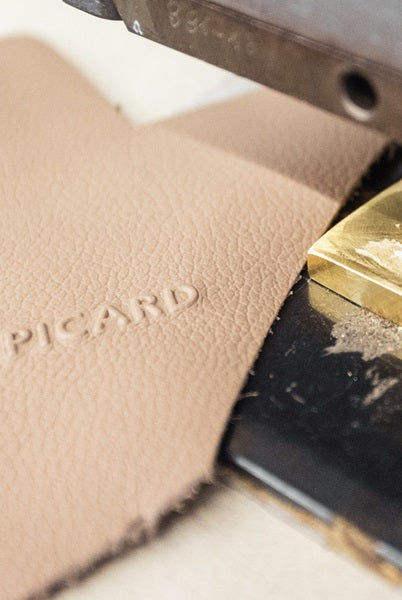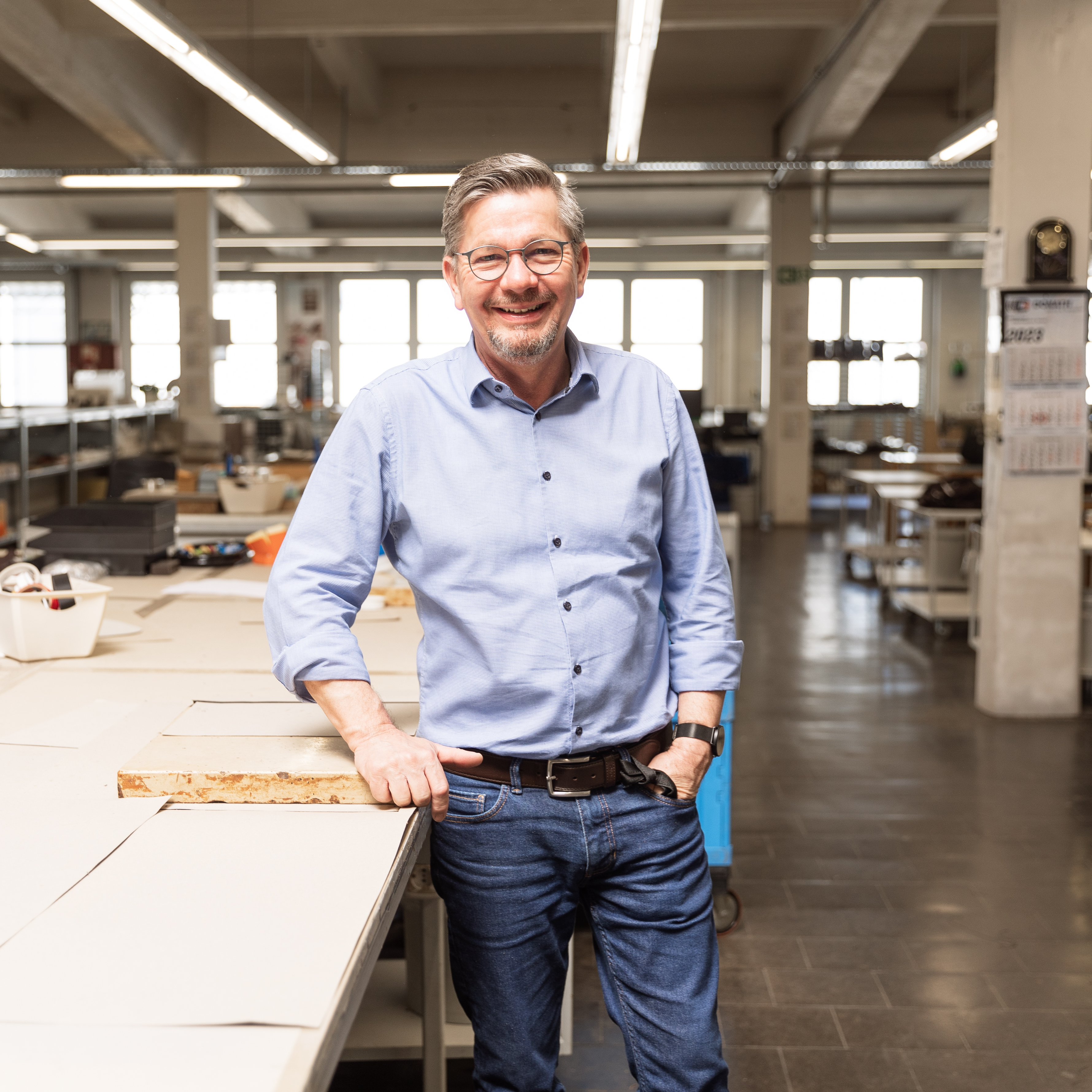Bonded leather and synthetic leather – two materials that are becoming increasingly important in the world of leather goods. But what is the difference between them?
In this guide, we will look at the details of these two leather materials and show you why they are becoming increasingly popular.
From the properties to the manufacturing to the diverse applications – we cover everything.
Whether you are looking for vegan alternatives to leather or simply want to learn more about bonded leather – you have come to the right place!

What is bonded leather?
Bonded leather, often considered an environmentally friendly alternative to traditional leather , is an innovative material made from leather scraps, binders and fatliquoring agents .
These components are processed into a homogeneous mass , which is pressed between two layers of fabric and often provided with a PU coating .
This gives the bonded leather a look that is very similar to real leather . Bonded leather has a wide range of uses, for example in upholstery production, in bookbinding, in fashion accessories such as belts and bags, and in the shoe industry. Its popularity is growing steadily, not least because of its vegan variants and the positive bonded leather experiences of many users.
What are the advantages and disadvantages of bonded leather?
Advantages:
-
Inexpensive: Bonded leather is usually cheaper than real leather.
-
Environmentally friendly: The production uses leather scraps and thus reduces waste.
-
Versatility: The material is suitable for a wide range of products.
- Easy to care for: Bonded leather is easier to clean than real leather.
Disadvantages:
-
Less durability: It is not as long-lasting as real leather.
-
Susceptibility to damage: The surface can crack or peel more easily.
-
Difficult to repair: If damaged, it is more difficult to repair.
-
Less breathability: It does not offer the same breathability as real leather.
- Limited feel: The feel may differ from real leather.
What is synthetic leather?
Synthetic leather, also known as imitation leather, is a synthetic material that imitates the look and feel of real leather.
It is mainly made from polyvinyl chloride (PVC) or polyurethane (PU) and offers a cost-effective alternative to genuine leather.
Expert knowledge : Synthetic leather is used in a wide range of applications, including the fashion industry for jackets, trousers and handbags, furniture manufacturing for sofas and armchairs, and the automotive industry for seat covers.
Its popularity is due to its versatility and ability to take on different textures and colors.
What are the advantages and disadvantages of artificial leather?
Advantages:
-
Cost-effective: Artificial leather is often cheaper than real leather.
-
Easy care: It is water-repellent and easy to clean.
-
Animal friendly: No animal products are used in its production.
-
Versatile: It can be made in different colors and textures.
- Stain and water resistant: It is less susceptible to stains and water damage.
Disadvantages:
-
Less durability: It tends to wear out faster than genuine leather.
-
Less breathable: It does not offer the same breathability as real leather.
-
Environmental impact: Production can be harmful to the environment.
-
May peel or crack: The surface may become damaged over time.
- Lower quality: It is often considered to be of lower quality than genuine leather.
Differences between bonded leather and synthetic leather
Bonded leather and synthetic leather each offer unique properties and benefits that make them attractive for different applications.
While both materials are alternatives to genuine leather, they differ in their composition, processing and the final product.
Here we take a look at the main differences between these two materials in terms of processing options, quality, feel and price.
Processing options
➽ Leather fiber: This material is made from leather scraps that are processed into a homogeneous mass and pressed between layers of fabric.
It is particularly suitable for products where leather aesthetics are required but the full durability of genuine leather is not needed, such as book covers or shoe insoles.
➽ Artificial leather: Artificial leather is made from synthetic materials such as PVC or PU and can be produced in a variety of colors and textures.
It is often used for fashion items, furniture and car interiors where a leather-like look is desired but costs should be kept low.
Quality
➽ Bonded leather: Although bonded leather can offer high quality in terms of appearance and feel , it is generally less durable than genuine leather.
It is well suited for applications where aesthetics are important but extreme durability is not required.
➽ Artificial leather: Artificial leather can vary greatly in quality , depending on the materials used and the manufacturing technique.
High-quality synthetic leather can be very close to real leather, but tends to wear out faster.
Haptics
➽ Bonded leather: Bonded leather often feels a little stiffer than real leather and can have a less natural texture .
However, the feel can be improved through various processing techniques.
➽ Artificial leather: The feel of artificial leather varies depending on the quality. High-quality artificial leather can feel very soft and almost like real leather , while cheaper versions often feel hard and plastic-like.
Price
➽ Bonded leather: Bonded leather is usually cheaper than genuine leather because it is made from leftover materials. This makes it a cost-effective option for many applications.
➽ Synthetic leather: Synthetic leather is often the cheapest option among leather alternatives. However, the price can vary depending on the quality and manufacturing process .
Environmental compatibility
➽ Bonded leather: Since bonded leather is made from manufacturing waste, it is considered a more environmentally friendly option . It helps reduce waste and use resources more efficiently.
➽ Synthetic leather: The environmental impact of synthetic leather depends greatly on the materials and manufacturing processes used . Some types of synthetic leather can be harmful to the environment, especially if they contain PVC .
Conclusion
In the world of leather alternatives, bonded leather and synthetic leather are in the spotlight as two exciting options.
While bonded leather scores points with its environmentally friendly production and the use of leather scraps, artificial leather offers a cost-effective and versatile alternative.
Both materials have their specific advantages and areas of application, although the decision ultimately depends on individual needs and values. Whether you choose environmentally friendly bonded leather or versatile synthetic leather - both materials offer exciting opportunities to rediscover the world of leather goods.
FAQ
Is bonded leather completely animal-free?
If a material is described as bonded leather, it is not animal-free. Traditionally, bonded leather contains a certain amount of real leather fibers that come from animals.
Vegan versions do exist, but these are referred to as synthetic leather. They completely avoid animal components and are instead made from plant-based or synthetic fibers. These vegan options offer an aesthetic alternative to conventional leather. They are ideal for consumers who value environmental and animal welfare, but still appreciate the leather aesthetic.
How long does faux leather last compared to real leather?
Artificial leather tends to wear out faster than real leather. The lifespan of artificial leather depends on the quality of the material and the intensity of use. High-quality artificial leather can last for several years if well cared for, while cheaper variants can show signs of wear more quickly.
Can bonded leather be easily repaired?
Bonded leather is more difficult to repair than genuine leather. Due to its composition and structure, damage such as cracks or flaking cannot be repaired as easily. In the case of major damage, a complete replacement of the affected part is often necessary.
Is artificial leather environmentally friendly?
The environmental friendliness of synthetic leather varies depending on the materials and manufacturing processes used. Some types of synthetic leather, particularly those containing PVC, can be harmful to the environment. However, there are also more environmentally friendly variants that rely on more sustainable materials and production methods.
What care does bonded leather require?
Bonded leather is relatively easy to care for and can be cleaned with a damp cloth. It is advisable to avoid aggressive cleaning agents so as not to damage the surface. Regular care will help maintain the appearance and lifespan of the material.
Find out more by reading our other articles:








